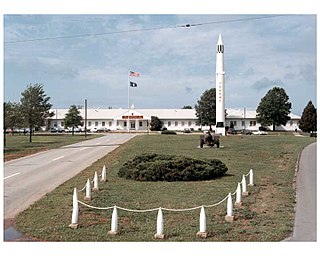
An analog computer or analogue computer is a type of computer that uses the continuous variation aspect of physical phenomena such as electrical, mechanical, or hydraulic quantities to model the problem being solved. In contrast, digital computers represent varying quantities symbolically and by discrete values of both time and amplitude.

Whirlwind I was a Cold War-era vacuum tube computer developed by the MIT Servomechanisms Laboratory for the U.S. Navy. Operational in 1951, it was among the first digital electronic computers that operated in real-time for output, and the first that was not simply an electronic replacement of older mechanical systems.

Redstone Arsenal (RSA) is a United States Army post and a census-designated place (CDP) adjacent to Huntsville in Madison County, Alabama, United States and is part of the Huntsville-Decatur Combined Statistical Area. The Arsenal is a garrison for various tenants across the Department of Defense, Department of Justice, and NASA. RSA has benefited from decisions by the Defense Base Realignment and Closure Commission. The Redstone Arsenal CDP had a residential population of 837 as of the 2020 census. The base contains a government and contractor workforce that averages 36,000 to 40,000 personnel daily.

Sperry Corporation was a major American equipment and electronics company whose existence spanned more than seven decades of the 20th century. Sperry ceased to exist in 1986 following a prolonged hostile takeover bid engineered by Burroughs Corporation, which merged the combined operation under the new name Unisys. Some of Sperry's former divisions became part of Honeywell, Lockheed Martin, Raytheon Technologies, and Northrop Grumman.
Draper Laboratory is an American non-profit research and development organization, headquartered in Cambridge, Massachusetts; its official name is The Charles Stark Draper Laboratory, Inc. The laboratory specializes in the design, development, and deployment of advanced technology solutions to problems in national security, space exploration, health care and energy.

The MIT Lincoln Laboratory, located in Lexington, Massachusetts, is a United States Department of Defense federally funded research and development center chartered to apply advanced technology to problems of national security. Research and development activities focus on long-term technology development as well as rapid system prototyping and demonstration. Its core competencies are in sensors, integrated sensing, signal processing for information extraction, decision-making support, and communications. These efforts are aligned within ten mission areas. The laboratory also maintains several field sites around the world.
Ivan Alexander Getting was an American physicist and electrical engineer, credited with the development of the Global Positioning System (GPS). He was the co-leader of the research group which developed the SCR-584, an automatic microwave tracking fire-control system, which enabled anti-aircraft guns to destroy a significant percentage of the German V-1 flying bombs launched against London late in the Second World War.
The Naval Ordnance Laboratory (NOL) was a facility in the White Oak area of Montgomery County, Maryland. It is now used as the headquarters of the U.S. Food and Drug Administration.

Naval Tactical Data System (NTDS) was a computerized information processing system developed by the United States Navy in the 1950s and first deployed in the early 1960s for use in combat ships. It took reports from multiple sensors on different ships and collated it to produce a single unified map of the battlespace. This information could then be relayed back to the ships and to the weapons operators.

The United States Naval Surface Warfare Center Dahlgren Division (NSWCDD), named for Rear Admiral John A. Dahlgren, is located in King George County, Virginia, in close proximity to the largest fleet concentration area in the Navy. NSWCDD is part of the Naval Surface Warfare Centers under the Naval Sea Systems Command (NAVSEA). NSWCDD was initially established 16 October 1918 as a remote extension of Maryland's Indian Head Proving Ground used for testing naval guns. The Dahlgren site was named the Lower Station, Dahlgren Naval Proving Ground when it first opened. The location on the Potomac River was specifically chosen for the development of a long ballistic test range on the Potomac River, required for the testing of modern, high-powered munitions.
The Aerospace Corporation is an American nonprofit corporation that operates a federally funded research and development center (FFRDC) in El Segundo, California. The corporation provides technical guidance and advice on all aspects of space missions to military, civil, and commercial customers. As the FFRDC for national-security space, Aerospace works closely with organizations such as the United States Space Force and the National Reconnaissance Office (NRO) to provide "objective technical analyses and assessments for space programs that serve the national interest". Although the USSF and NRO are the primary customers, Aerospace also performs work for civil agencies such as NASA and NOAA as well as international organizations and governments in the national interest.

The Johns Hopkins University Applied Physics Laboratory is a not-for-profit university-affiliated research center (UARC) in Howard County, Maryland. It is affiliated with Johns Hopkins University and employs 8,000 people (2022). The lab serves as a technical resource for the Department of Defense, NASA, and other government agencies. APL has developed numerous systems and technologies in the areas of air and missile defense, surface and undersea naval warfare, computer security, and space science and spacecraft construction. While APL provides research and engineering services to the government, it is not a traditional defense contractor, as it is a UARC and a division of Johns Hopkins University. APL is a scientific and engineering research and development division, rather than an academic division, of Johns Hopkins.
REAC may refer to a number of different things:
The Defence Avionics Research Establishment (DARE) is a laboratory of the Indian Defence Research and Development Organisation (DRDO). Located in Bangalore, Karnataka, India, It is one of the two DRDO laboratories involved in the research and development of airborne electronic warfare and mission avionics systems.
The Counter-electronics High Power Microwave Advanced Missile Project (CHAMP) is a joint concept technology demonstration led by the Air Force Research Laboratory, Directed Energy Directorate at Kirtland Air Force Base to develop an air-launched directed-energy weapon capable of incapacitating or damaging electronic systems by means of an EMP.
Reeves Instrument Corporation (RICO) was a Cold War manufacturer of computer and radar systems for the United States. The corporation was the Project Cyclone laboratory operator for simulation of guided missiles, and RICO developed several Strategic Air Command combination (radar/computer/communications) systems.
The preliminary 1991 Base Realignment and Closure Commission list was released by the United States Department of Defense in 1991 as part of the ongoing Base Realignment and Closure Commission. The list recommended closing 28 major United States military bases throughout the nation. This was the last Base Realignment and Closure Commission prior to the dissolution of the Soviet Union ending the Cold War.
Samuel Lubkin (1906-1972) was a mathematician and computer scientist instrumental in the early history of computing.
Project Cyclone was a 20-year initiative of the US Office of Naval Research that lasted from 1946 to the mid-1960s. It was one of a series of projects whose purpose was to develop a computer laboratory with a company in the private sector that would do research and development on missile systems, as well as on classified problems in navigation, ballistics, engine control, electrical circuit analysis, and other fields. A secondary motivation was to strengthen the US's connections with civilian scientists and technology companies that had developed during WWII.
The Vulnerability Assessment Laboratory (VAL) was a research institution under the U.S. Army Materiel Command (AMC) that specialized in missile electronic warfare, vulnerability, and surveillance. It was responsible for assessing the vulnerability of Army weapons and electronic communication systems to hostile electronic warfare and coordinating missile electronic countermeasure efforts for the U.S. Army. VAL was one of the seven Army laboratories that merged to form the U.S. Army Research Laboratory (ARL) in 1992.







